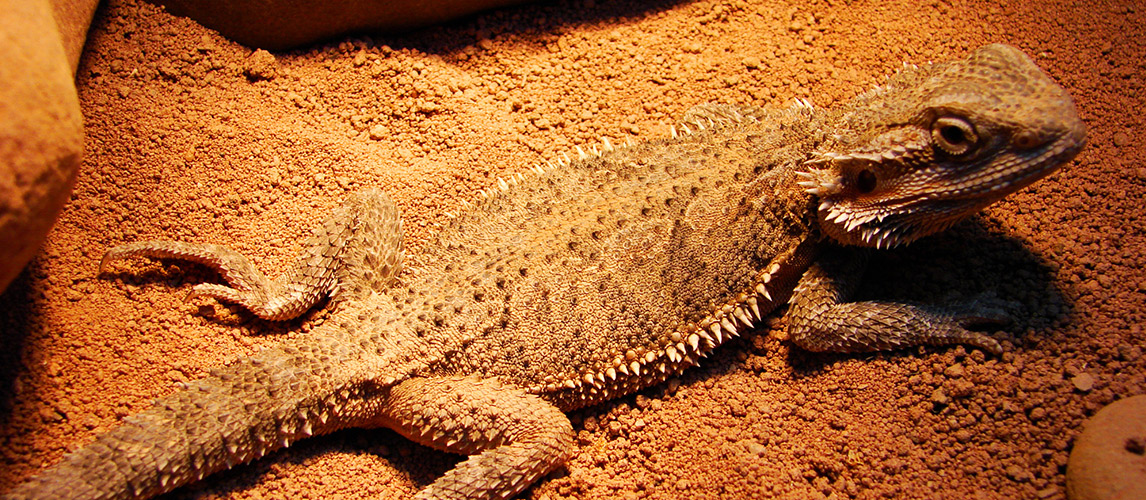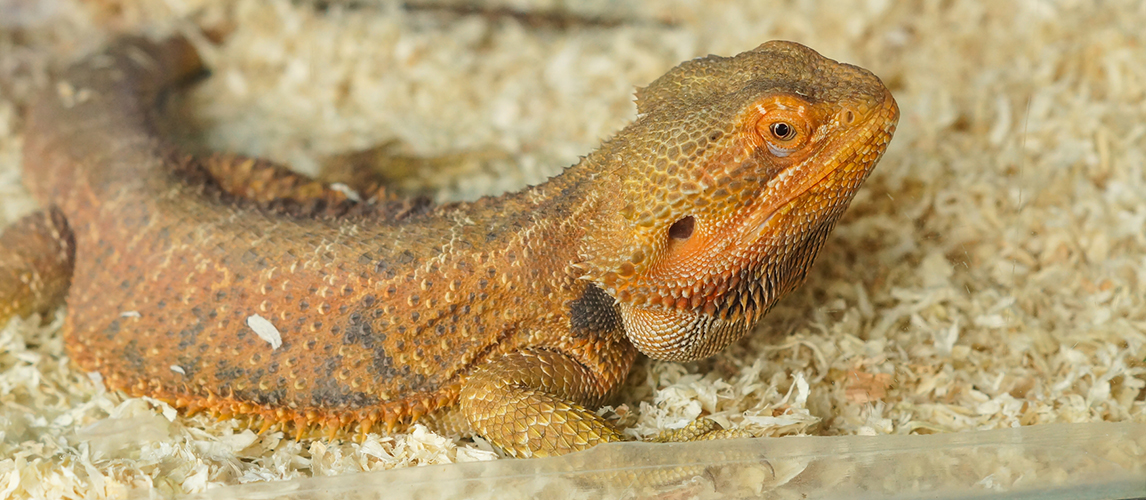Looking for some unusual pets? Well, why not?
Yes, dogs, cats and rabbits are cute but many people want something more exotic. One such choice that is becoming more popular day by day is the iguana. Belonging to the reptile family and looking rather cute in their early years, iguanas have largely become a common choice for a home pet. Well, if you are among that bunch who wants an iguana as a pet, you have landed yourself in the correct place! This article is your foolproof guide to getting and petting an iguana.
Since it differs from the usual line of pets such as dogs, cats and rabbits, iguanas do require some special care. Before getting yourself one as a friend, you must do your research well. It is important that you know everything needed for them; their habitat, habits, diet, hygiene and activity. You must be ready to invest a lot of time caring for your iguana.
If all these seem daunting to you, do not worry we have got you covered. Let us tick off the list one by one!
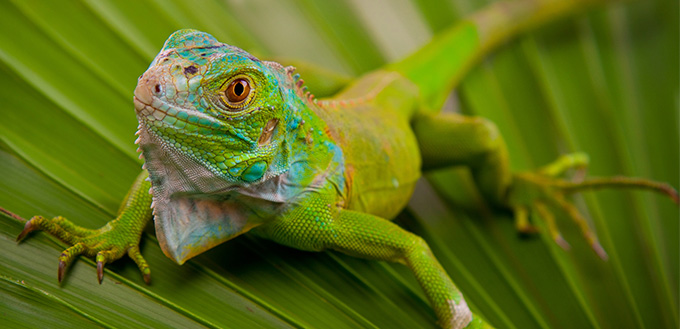
Law and Information
The first and foremost thing you must consider before purchasing an iguana is: will your country laws allow you to do so? Yes, iguanas are not any ordinary pet like cats, dogs or rabbits. They grow big fast and may become aggressive. Thus, many countries do not even allow keeping iguanas as pets. Even if you find your local pet store selling them, it is your responsibility to double check and ensure that your local laws regard it as safe.
Buying an iguana requires years of commitment; this can be as long as 20 years! Your local pet store may not always inform you about such considerations for the sake of earning money. Thus, you should do your own research beforehand rather realizing later it was a waste of money.
Contact a reputable pet store and go on an elaborate discussion about buying and caring for an iguana.
Color and Appearance
Among the many types, green iguana is the one that is most commonly kept as a pet. So for the rest of the article, we will discuss about iguanas keeping the green ones in mind mostly. The name green iguana is quite misleading because like a chameleon, iguanas also change colors. Although not as frequently and deliberately as a chameleon can, but iguanas can still alter their color to an extent. They are available in the colors and color combinations of brown, orange, red, black and blue.
More so, they alter their color under certain circumstances. For example, iguanas change color with changes in factors of the pecking order, health, age, mood, time of day and temperature. It is also believed that the region they originate from has an impact on the color. At the start of their life, iguanas have a bright green color. However, as they grow older, it turns to a dull grey. So do not be disappointed or frantic if your iguana changes in appearance, it is just an effect of aging.
Size and Strength
Initially sold as hatchlings, which are about the size of a mouse, these seemingly harmless creatures can grow up to six feet long when adult. Typically, the height ranges from five to seven feet long.
With age, iguanas become very strong and sturdy. If not tamed properly throughout their life, they can attack and slap with their tail. The tail alone is about half the size of their body. This makes them a very unsuitable pet for kids. Adult supervision is always required. The green iguana can weigh up to 20 pounds.
Another very important thing to keep in mind is that iguanas grow very rapidly. Before you know it, you may be housing an alligator indoors!
Habitat
Naturally, the ideal habitat for any iguana is out in the wild with a tropical climate. Some even like to live in rocky, steep areas with colonies. Iguanas are found in tropical and subtropical forests, deserts and coastlines.
You’ll find plenty of iguanas in Mexico, Fiji, Madagascar, Central and South America, the Galápagos Islands and on some of the Caribbean Islands. Green iguanas like to live near or around water and they are very good swimmers. In times of danger, they do not hesitate to jump in the water and seek protection.
Iguanas are cold-blooded creatures. This means they like to live in a warm climate and temperatures. This is important because being cold-blooded and barely furry – their only way of maintaining a warm body temperature is through their habitat and surrounding.
However, being a reptile enthusiast, we completely understand your love for iguanas. Therefore, we will guide you on building the ideal habitat so that your pet iguana can feel as homely and comfortable in your house as possible.
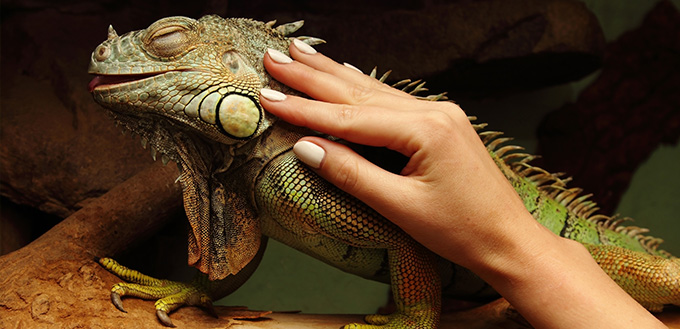
Housing and Terrarium
Now that you are familiar with the climate iguanas come from and prefer to live in, it will be easier for you to understand how to prepare the ideal housing for them. The most important thing you need to keep in mind when designing a house for your iguana is, they grow big very fast. If you are thinking the little pet you bought from the store will stay in that box for all its life, you are completely wrong! You will be amazed to see how fast these creatures grow.
They also have great longevity, about 15 to 20 years. Therefore, the enclosure you put them in must be well structured and full of their required facilities. You should plan for years to come.
Green iguanas are arboreal; this means they have a natural urge to climb. They also like to rest horizontally laid. Unlike other lizards, they will not stick to the surface of their terrariums. Iguanas also like to roam around freely inside their own dedicated territory. So, whichever size you choose must have a piece of tree trunk or bark.
Iguanas also like to move around so your terrarium must be both high and wide. The minimum recommended size is 150 x 160 x 75 cm or 60 x 63 x 30 inches. For easier conversion, it should be at least double its height and width. For maximum measurements, some pet enthusiasts also give up one whole room or closet for the comfort of their beloved pet!
The ideal temperature for your iguana during daytime is 28 to 32º C or 83 to 90º F. the temperature varies with the level of activity. During the night when the animal is less active, you can lower the temperature to 25° C or 77º F. Your iguana requires humidity ranging from 70% to 85%. You must provide it with a bowl of water, which must be changed every day. Along with it, there should be a wide and shallow container for bathing and cleaning. You can use any plastic or metal box for this purpose. Both of these must be cleaned on a regular basis.
The bottom of your terrarium should be aligned with a thick layer of gravel. The layer preferably should be 11 to 15 cm or 6 inches thick. Under this gravel, you can hide the cables that run for the bulb and heater. This will make for good heat rocks. Your iguana will also require lights so make sure the house has a working UVB 0.5 fluorescent light.
If you would rather prefer bulbs, then mercury vapor bulbs are a good choice. This light should be kept on for 10-12 hours a day and will require changing every few months. You can also install a basking heated lamp. Keeping light and temperature in moderation is very important because it directly affects their calcium and vitamin generation, which prevents it from a possible bone disease.
Diet
There are mainly three pillars that contribute to the health, well-being and longevity of an iguana. Among them, diet is one factor. The other two are habitat and humidity. Many factors need to be maintained when caring for a pet iguana. Young iguanas consume more food than adult iguanas. Iguanas are strictly vegetarian and the only time they should consume meat or insects is by accident. Although this is something, you should be very careful about and never let happen. They are herbivorous so they will require a leafy diet rich in dark leafy greens.
Fresh food is the key to your iguana’s good health and longevity. Provide your iguana with lots of fresh fruits and dark leafy greens. Avoid food that is high in protein content. Some great examples are kale, collard greens, mustard greens, turnip greens, green beans and asparagus. You can also feed it fruits such as banana but most of their diet must consist of leafy green vegetables. Somethings you want to avoid are iceberg lettuce and cabbage. These two add no nutritional value to its diet and on the downside can cause bad gastric problems.
Many people believe that they can feed cat food to their iguana. This is an absurd idea and misconception. Your cat food belongs to the cat only. In addition, as mentioned earlier, caring for an iguana is very different from caring for a typical pet such as a cat or dog. Your iguana will have to face the consequences of eating cat food that is both fatal and life-threatening.
In the past, there have been reported cases of iguanas developing kidney failures due to consumption of cat food. This will substantially reduce the life span of your reptile friend. Avoid store-bought and canned food for your iguana. Although many pet stores sell food with a food label saying they are for iguanas, these are of very little nutritional value. Often times they prove to be more harmful than beneficial for your iguana! These foods often contain artificial color and animal protein that are very unsafe for your pet.
Iguanas need plenty of phosphorus and calcium in order to keep their bones healthy. Their source of light also plays a major contributing role here. So opt for vegetables that are high in content of calcium and vitamin. You do not want your poor little friend to suffer from any bone disease.
In conclusion, the best thing to feed your iguana is a salad that you prepare yourself. It can consist of both fruits and vegetables. Make sure you clean and wash the vegetables and fruits properly. Cut them into small pieces so it is easy for your little pet to consume. Keep away from stale food and always opt for the fresh ones.
As young iguanas eat more than the older ones, they require food supply daily. For the older iguanas, meals on alternate days will work fine. You need to provide it with fresh water during feeding and in between meals. Along with the aforementioned foods, calcium supplements will prove beneficial.
Additionally, they may also require vitamin supplements but they should be taken only after a certified vet prescribes it. Doing regular blood tests will help you monitor its calcium levels. Maintaining a proper surrounding temperature is also important because it helps your iguana digest its food better.
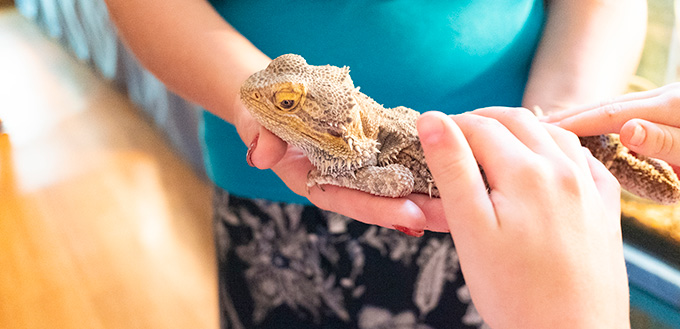
Health and Hygiene
As you already know many things that are necessary to do in order to maintain an iguana’s good health, maintenance of good hygiene is equally important. Spending time with your iguana, you should also look out for signs. If something is wrong with its health, you will notice evident signals.
Better be safe than sorry. You should take your iguana to a specialized vet regularly for a checkup. In this way, the iguana’s health will be under constant monitoring. You will know beforehand of any upcoming health issues and can take necessary precautions. In addition, your local vet may not be qualified enough for an iguana. You must look for a specialized or exotic vet and ensure that the person is readily available in case of emergencies.
Sometimes changes in the iguana’s skin give hints regarding its health. Take note of changes in the color or brightness of the skin, skin fading or any other physical changes. These are clues that it is time to take your pet iguana to a vet. Lack of hygiene may result in white spots on your iguana’s skin. This means that the mites are colonizing its dermis. In order to get rid of those, bathe your iguana properly in lukewarm water and clean its housing thoroughly.
To maintain sufficient hygiene, a professional should cut your pet iguana’s nails from time to time. Your iguana may also suffer from ticks at one time. Simply remove these with the help of a tweezer. Try to maintain a stable and suitable temperature at all times as a sudden drop may cause respiratory infections because of pathogens.
At times, iguanas can be a matter of concern for your own health. Iguanas carry salmonella in their digestive tracts. This bacteria can prove fatal health consequences for humans. Normally, maintaining proper hygiene while handling iguanas shall be sufficient to keep any problems at bay. However, for the weaker people such as pregnant woman, young children, elderly people or people with a compromised immune system, this can be risky.
So, if you are planning to bring home an iguana and if anyone in your house is pregnant or fits the particular age group that we talked about, it is not a good decision. You’d better look for another pet rather than a reptile.
Activity
In the wild, iguanas really just like to bask in the sun or rest on a tree branch. So in captivity, that is pretty much all they will do. Baby iguanas seem very cute and are buggers. They can be entertaining to watch. However, as your baby iguana grows older, they become extremely docile and lazy. Do not expect any sort of activity from your iguana such as dancing, playing or entertaining. This is how they have lived in the wild for ages so you will not be able to change that.
You need to be careful when encountering your iguana. Keep in mind, their pudgy little bodies when young may scream cuteness and cuddle; but cuddling is something they do not like. To be on the safe side, you should avoid it. As they live in the wild with their kind of species, human contact is something unnatural to them. Naturally, they will move away from you if you try to touch them. When you bring a baby iguana home, you should take it in your lap at least once daily.
This ritual is very important for taming purposes. It will take time, but eventually the little iguana will submit to this act. Always grab your iguana gently by the belly, on the area in front of its legs. This will also give the iguana a sense of security when you are around.
Some iguanas become too attached and like to climb on to the owner. It may seem cute but remember iguanas are not furry creatures like cats or rabbits. They have sharp claws and that is not something wonderful to dig into your skin. Do not shove off your iguana if they try to do that because it will only make them more aggressive. Instead, when you take it out of its enclosure, make sure you wear protective clothing. Plastic clothes or thick woolen sweaters are good options.
Never grab an iguana by its tail. That long, beautiful tail may seem alluring for you to hold, but it can lead to dire consequences. Grabbing an iguana’s tail is a threat for them. When they are in moments of extreme emotion, such as threat, anxiety or fear, their tails fall off on their own. Yes, like other reptiles of the family, sadly this is also possible for the iguana.
However, the good news is that their tails regenerate. This means that even if their tail falls off, it will grow back, only once. This time it will not be as big, beautiful and bold as it originally was. Furthermore, if for any reason it falls off for the second time, it will not grow back for a second time. Then the iguana loses its majestic tail forever!
Care and Precaution
A very important thing to bear in mind when keeping an iguana in your house is that with time, they can in fact turn into dangerous creatures. Their tail is part of their de facto defense mechanism. If severely aggravated, they can attack with their tail. As they are creatures of the wild who are unsuitable to the domestic world, attacking is a natural instinct for them. One slash of the tail is enough to break a human bone.
There have been multiple reported cases in the past of broken arms due to this accident! Iguanas also have sharp teeth, and in extreme cases, they can use them to attack. Thus, be very careful as not to agitate your iguana.
When you get a baby iguana home, until the age of six to eight months old, they are considered safe. However, when they reach the age of two, they can become quite aggressive. This is common especially in the male gender and they get harder to tame. You should watch your iguana’s mood as their behavior has a lot to say about their mood.
If your iguana aggressively opens its mouth or whips its tail, do not panic just leave it alone. This means it does not want to be disturbed. Never leave your iguana alone with a kid, adult supervision is absolutely mandatory.
Training your iguana can be a difficult task. Since its early years, you should let it loose for an hour each day and interact. This should be done in an open area under supervision of course. You should be very patient and not hope for results anytime soon. With the correct approach, you will begin to see results in three years’ time. Making this a daily ritual will form a special bonding between you and your iguana. This will considerably help your pet activity throughout the rest of its life.
Costs
By now, you are well aware that owning an iguana comes with a lot of dedication and responsibility. Buying an iguana is not costly but you will have to pay for several expenses throughout its life. These expenses include caring for it, providing for its diet, housing and cleaning which includes thermal and heat expenses. Additionally, there are expenses for maintaining health and hygiene and visiting a vet regularly.
Throughout its lifetime, only providing for a good habitat and food will cost you hundreds of dollars. Not to mention the amount of time you will be investing. We are talking about 10 years and more time. So as a final note of advice, be prepared and willing to take on the financial and spatial burden if you really want to own an iguana.
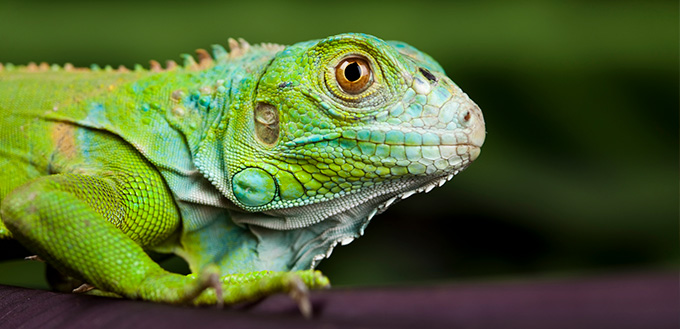
Some Fun Facts
- Iguanas have a dinosaur-like appearance making them the ideal pet if you ever wanted a dinosaur.
- Although lazy and docile, they are smart enough to learn commands and respond to their caregiver’s voice.
- They have great water and land capabilities. Iguanas can swim underwater for more than 20 minutes, are very quick on land and can survive falls from 40 feet high.
- According to some sources, people farm and eat iguanas in Central and South America.
Sources:
- Christina N. De Jesús Villanueva, Origin Of The Green Iguana (Iguana Iguana) Invasion In The Greater Caribbean Region And Fiji, Springer
- John M.Kelso MD, Allergy To Iguana, ScienceDirect
- Laurie Hess, DVM, Housing Pet Iguanas, VCA Hospitals



